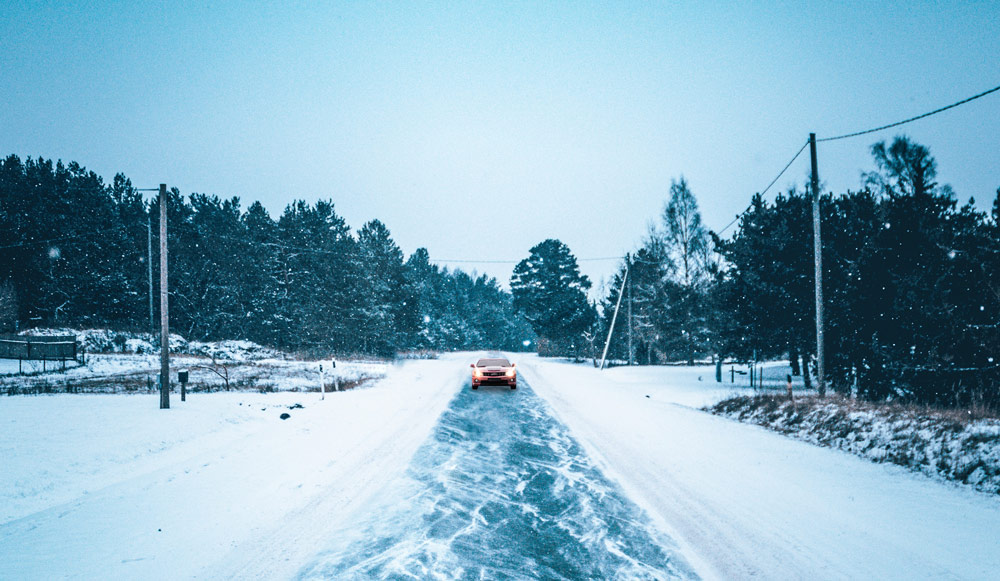In many parts of the country, winter brings snowy and icy weather and blistering cold conditions. As the temperature drops, ice patches glaze atop roads and highways, leading to dangerous driving conditions and increasing the risk of an accident. According to the U.S. Department of Transportation Federal Highway Administration, more than 1,300 people die each year because of winter-weather-related road conditions.
Driving on snowy, icy, wet pavement requires more care, extra caution, and increased diligence. Follow these winter driving safety tips to navigate dangerous weather-related road conditions.
Table of Contents:
- Winter Driving Statistics How to Drive on Ice
- What is Black Ice
- How to Drive on Black Ice How to Drive in Snow
- Front Wheel Drive In Snow and Ice
- Is All-Wheel Drive Good in Snow?
- Rear-Wheel drive in Snow Snow Tires: Pros and Cons
Synopsis:
Winter weather conditions lead to more than 1,300 deaths per year and more than 116K injuries. Proper navigation techniques help drivers stay safe on slick, wet, snow-packed roads.
Missouri Winter Driving Statistics
Weather conditions in the winter vary each year across Missouri. According to 2021 crash statistics published by the Missouri Department of Highway Patrol, bad weather conditions only accounted for 16 percent of all accidents. August reported the highest number of traffic fatalities, 121. Yet, while weather issues played a minor role in accidents, some conditions were linked to more accidents and fatalities. The graph shows fatalities and crashes by specific weather conditions:
How to Drive on Ice
Missouri’s icy roadways contributed to 474 accidents in 2021, but thankfully, none were fatal. Driving on ice requires caution and a bit of navigational finesse. When the temperatures drop at night, wet surfaces glaze over, leading to a problematic early-morning commute. Knowing how to navigate these slick surfaces improves everyone’s safety on the road.
Drivers must be mindful of two types of ice: white and black. White ice is the standard ice that most drivers notice glazing the roadways; this ice might be packed with snow. Black ice is a bit more dangerous, as it’s invisible to drivers.
What is Black Ice?
Black ice refers to seemingly invisible ice patches. Roadways covered in black ice might look shiny, but typically, black ice catches drivers off guard. When driving during extreme cold or on a morning following a night of freezing temperatures, drivers must always be mindful of the possibility of black ice on highways and other roads.
Since black ice isn’t easily visible, drivers must assume they will encounter this hazard. During the morning or evening commute, take these precautions:
- Increase the distance between other vehicles.
- Drive slower.
- Watch drivers up ahead; if drivers see other cars sliding, be prepared to react.
.
How to Drive on Black Ice
Hitting a patch of black ice can feel scary, but staying calm (and cool) is extremely important. When a driver hits black ice, the car might slide or skid. To navigate a slide, turn into the slide (don’t jerk the steering wheel in the other direction). Remember to keep speeds slower, too. Do NOT ACCELERATE OR HIT THE GAS! Sliding on ice requires reducing the speed, not increasing the speed. The loss of acceleration combined with turning into the slide helps the driver take control of the car and navigate out of the icy patch.
Missouri snow can be wet or dry, and the snowfall varies, too. Snow can be light and nearly nonexistent (flurries) or extremely heavy. Blizzards are not uncommon in the metro area, and these heavy snowfalls lead to whiteout conditions. Driving in snow is similar to driving on icy roads, but there are a few navigational differences. For example, heavy snow leads to very cumbersome road conditions (especially when plows have not initiated mitigation).
When driving in snow, remember to:
● Turn on headlights (this helps the car remain visible to other drivers)
● Slow down the speed. Follow the lead of other drivers on the road.
● Maintain a safe distance. Be sure to allow more space between other vehicles.
● Turn on windshield wipers and use defoggers.
● Activate hazards when drivers need to pull to the side of the road for safety.
● Turn into a slide and do not accelerate to gain control of a sliding vehicle.
A Vehicle’s Transmission Impacts its Handling in Winter Weather
Vehicles offer different types of transmissions that control navigation. Automatic and manual transmission refers to the type of transmission control; automatic means that the vehicle is programmed to select the best gear for a specific driving scenario. Vehicles with manual transmission require the driver to select the ideal gear.
The transmission also dictates how the tires engage during the drive. Transmissions feature the following functional power to the tires:
● Front-wheel drive
● Rear-wheel drive
● All-wheel drive
● Four-wheel drive
Each powertrain design handles winter weather differently. Here’s what drivers need to know about how transmission power to the tires impacts navigation during slick and snowy conditions.
Front Wheel Drive in Snow and Ice
Cars or vehicles with front-wheel drive refer to a transmission that delivers power only to the front wheels. Many cars are front-wheel drive, which handles well in snow and ice. More weight also pulls on the front wheels, and the extra weight aids grip and traction. Front-wheel drive comes standard on many vehicle models. Car buyers need to understand that front-wheel drive is abbreviated as FWD. Novice car buyers mistake this abbreviation for a four-wheel drive (which is abbreviated as 4WD).
Is All-Wheel Drive Good in Snow?
All-wheel drive delivers equal power to all four wheels. This aids and improves traction, but it is NOT the same as four-wheel drive. The all-wheel drive automatically engages when necessary, and AWD can be used on dry and wet surfaces. In contrast, 4WD is ideal for off-road conditions and snowy roads. However, 4WD should not be used on dry pavement. Drivers also need to engage 4WD capabilities manually.
Rear-Wheel Drive in Snow
Sports cars and some pickup trucks feature rear-wheel drive. Unfortunately, vehicles with this drivetrain navigate winter weather roadways poorly. When the power is only delivered to the rear wheels, the front of the vehicle is lighter. This leads to the back tires spinning on slippery and wet pavement.
Snow Tires: Pros and Cons
Snow tires are designed with grooves or added grips to handle the slick, slippery, snow-packed winter pavement. While snow tires are not necessary, many drivers find them beneficial when navigating the worst Missouri winter conditions. While snow tires provide an additional element of safety and control on slick and snowy pavement, these special tires can only be used in winter. They need to be swapped out during warmer months, and the added cost of purchasing two different types of tires might not be financially feasible for those on a tighter budget. How much should drivers budget for snow tires? Many brands start at less than $100 per tire and go to more than $230 per tire. The size and brand impact the cost.
Tire Chains for Winter Weather Navigation
Those who don’t have the added budget for purchasing snow tires might opt to install tire chains on SUVs and pickup trucks. These tire accessories provide additional grip and traction on snow-covered and ice-glazed roads.
Tire chains are easy to remove and install. Once the winter weather clears, drivers take off the chains and use their standard tires.
Common Sense Safety Advice for Winter Weather Driving
Knowing the basic safety tips for driving in snow and ice helps drivers confidently navigate these hazardous conditions. However, most Missourians also need to practice practical safety habits during winter.
Pay Attention to the 10-Day Weather Forecast
Technology provides drivers with advanced warning of winter weather. Pay attention to weather reports and stay up-to-date about upcoming snow or ice predictions. KSDK, KMOV, KTVI, the Weather Channel, and NOAA.gov provide weather forecasts for advanced winter weather warnings. Knowing road conditions ahead of time enables drivers to prepare and stay safe.
Pack a Cold Weather Emergency Car Kit
Every car should include an emergency kit that includes the necessities in case the weather leaves drivers stranded. Always include the following items in a winter weather emergency kit:
● Cell phone charger
● Flashlight and extra batteries
● Water and nonperishable food
● Extra blankets
● Hat, mittens, scarf, etc.
● In ice/snow scraper
● Tire jack
● Spare tire
● Jumper cables
● First aid kit (bandages, ointment, tweezers, pain reliever, etc.)
● Shovel
● Sleeping bag
● Umbrella and poncho
● Snow boots
● Road flares or warning signs
Stay Home
When bad weather threatens road safety, be smart and stay home. Only venture out in snowy or icy conditions if it is necessary.
FAQ: Driving in Winter Weather
Is it safe to drive in a winter weather advisory?
When winter weather is in the forecast, please stay home! More cars on the road make the commute much more dangerous for everyone.
What to do when driving in a blizzard?
During blizzard conditions, visibility might be minimal (known as white-out conditions). Keep headlights on, and drive slowly. Pull over when it’s safe (at a rest stop, gas station, or, ideally, home).
What are snow tires?
Snow tires offer better grip and traction and are designed specifically to navigate snow and ice. These tires cannot be used during warm seasons.
What should I have in my winter survival kit?
Pack all the necessities you might need to survive during a cold night. Rescue vehicles might be delayed in extreme weather, so drivers and passengers need key items to stay warm and safe. Always pack extra blankets, hats, mittens, a sleeping bag, a flashlight (and batteries), food, and water. In addition, refer to our comprehensive survival recommendations in the article.
When driving in snow, what lights should you use?
Always turn on headlights when driving in the snow, but please opt for low beams.


